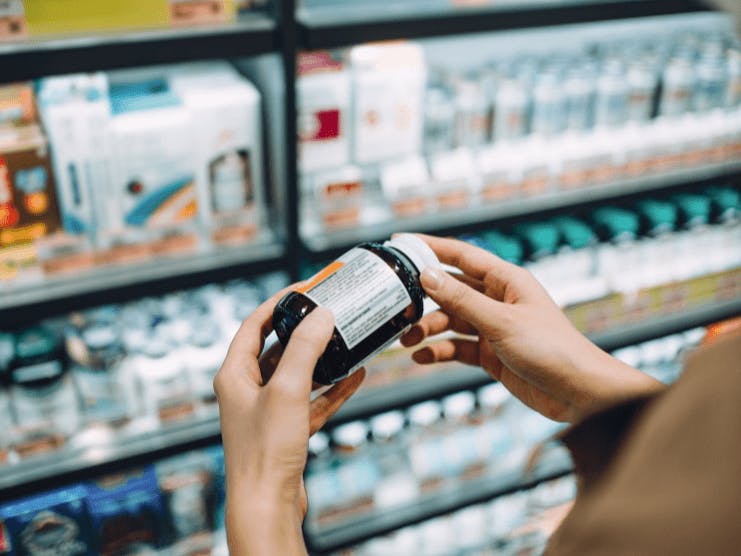
Choosing a multivitamin from the sea of options is no easy task. Use these expert tips to find the best one for you.
Most Americans take vitamins, minerals, or herbs these days, and older adults are no exception. In fact, a 2019 survey found that more than 4 in 5 adults take dietary supplements.
And it's no wonder so many people choose multivitamins specifically. They’re a great way to cover your nutritional bases without collecting a cabinet full of individual supplements.
“I think of multivitamins as insurance,” says Bonnie Taub-Dix. She’s a registered dietitian and the author of Read It Before You Eat It: Taking You From Label to Table. Multivitamins can fill gaps in an otherwise healthy diet and ensure you get enough nutrients that become vital once you reach 50.
That said, there are a few points to keep in mind for getting the most from your supplement. Here’s what to look for when shopping for a multivitamin.
Tip #1: Aim for doses close to 100% of your daily needs
Before buying a multivitamin, look at the nutrition facts label. Many supplements list the specific amount of each nutrient it offers. They also list the percent of your daily value (DV). The DV is the recommended amount of nutrients you need per day. The percent of DV tells you how much a nutrient in your multivitamin contributes to your daily diet
There are specific nutrients you need more of as you age (we’ll cover these shortly). That said, look for a multivitamin that provides 100% of your DV or close to it. “You don’t need a mega super-vitamin supplement that provides 5,000% of what you need,” Taub-Dix says. “Just because some is good doesn’t mean a tremendous amount is better.”
Related reading: What does a perfect day of eating really look like?
Tip #2: Prioritize specific nutrients
When you check a supplement label, zero in on these nutrients to ensure they’re at or close to 100% of your DV.
- Calcium: “As you get older, calcium becomes very important,” Taub-Dix says. Calcium is vital for building bone and preventing bone loss. But if you have low bone density (for example, osteoporosis or osteopenia), you may need to take a calcium supplement in addition to a multivitamin, Taub-Dix says. Talk to your doctor or a registered dietitian to get personalized recommendations.
- Vitamin D: Also known as the sunshine vitamin, vitamin D pairs with calcium to keep up your bone density. “Vitamin D is like an assistant to calcium,” Taub-Dix says. It enhances the way calcium is absorbed.
- Vitamin B12: Your body needs vitamin B12 to keep your nervous system healthy and create red blood cells. However, certain medications (such as metformin and proton pump inhibitors) can make it harder to absorb vitamin B12. So can digestive conditions, which are more common as we age.
- Magnesium: This mineral is also essential for bone health. But in addition, magnesium helps regulate muscle and nerve function, blood sugar levels, and blood pressure.
- Potassium: Taub-Dix says most of us don’t get enough potassium in our diets. In fact, potassium deficiencies are so common that the U.S Food and Drug Administration now requires manufacturers to list potassium on food labels. Potassium helps your muscles contract and your nerves fire. It also helps the heart and kidneys do their job.
Tip #3: Watch out for certain vitamins and minerals
People over 50 may need less of certain nutrients, thanks to age-related changes and an increased likelihood of chronic health conditions. In some cases, getting too much of a nutrient can cause severe side effects.
Be wary of high DVs on any of the following vitamins and minerals:
- Vitamin K: This vitamin plays a role in blood clotting, which can be a problem if you take blood thinners, Taub-Dix says. Talk to your doctor about how much vitamin K to aim for per day.
- Iron: The need for iron dips with age. Women, in particular, don’t need as much iron once they reach menopause, Taub-Dix says. There’s little risk of iron overload in healthy adults, but getting too much at once can cause constipation, abdominal pain, nausea, vomiting, and faintness. Aim for 18 milligrams (mg) of iron per day.
- Potassium: The majority of us need more potassium, but some folks are at risk of getting too much. Namely, people with chronic kidney disease and those who take ACE inhibitors or potassium-sparing diuretics. If this is you, talk to your doctor.
Collecting too much potassium in your blood can lead to side effects such as muscle weakness, numbness, and nausea. It could even lead to more serious issues, such as heart palpitations or shortness of breath.
Tip #4: Look for third-party verification
Unfortunately, the FDA doesn’t require manufacturers to prove that their supplements are safe and effective before they’re sold.
This is where third-party testing agencies come into play.
Third-party agencies test supplements to verify that what’s on the label is in the bottle. They also check that the supplement doesn’t contain undeclared ingredients or contaminants.
How can you tell if a supplement has had this extra testing? “The supplement will have a badge on the bottle with the company that conducted the assessment,” says Jonathan Purtell. He’s a registered dietitian with Lenox Hill Hospital in New York City.
Notable third-party agencies include NSF International, ConsumerLab, and United States Pharmacopeia (USP). If one of these names appears on the label, your multivitamin has been tested.
Tip #5: Consider a multivitamin geared toward people 50 and up
For most people, a regular multivitamin will be enough to cover the bases, Purtell says.
However, multivitamins marketed toward the 50-plus crowd tend to have the ideal amount of nutrients needed. “Some multivitamins for older adults may be more geared toward vision or heart health and have more of the vitamin D and calcium that you might not have in other multivitamins,” Taub-Dix says.
Whether you choose a standard multivitamin or one marketed toward older adults, check the label to be sure it contains the nutrients you need.
Tip #6: Get your doctor involved
Taking a multivitamin in combination with medications or other supplements can lead to overdose or severe side effects. So it’s a good idea to clear your multivitamin with your doctor if you have a medical condition or are taking medications.
There’s a wide range of multivitamins on the market. That’s why Taub-Dix recommends bringing your supplement bottle to your next appointment so that your doctor or dietitian can look over the label.
Consider seeing a registered dietitian, though, if you have a chronic condition. “Not only would they be able to counsel you on which multivitamin may be best, but they could also tailor your diet toward your particular needs,” Taub-Dix says.
Tip #7: Think “food first”
There’s a reason multivitamins are called supplements. They help fill in the gaps. But they’re not a replacement for a healthy diet.
Vitamins and minerals in their food form are often better absorbed. They also come with a whole host of other health-boosting nutrients. For example, getting vitamin C in a supplement isn’t the same as getting it from an orange, grapefruit, or strawberry, Taub-Dix says. A piece of fruit includes not only that vitamin C, but also fiber and antioxidants.
Your job: “Focus on incorporating whole, nutrient-dense foods such as fruits, vegetables, lean proteins, and whole grains into your diet to provide a well-balanced intake of nutrients,” Purtell says.
It pays to be choosy when picking a multivitamin. At their best, multivitamins can help ensure you’re getting the nutrients you need to stay healthy, active, and independent.
Additional Resources
2019 Supplement Use Survey
External Website Link
How much vitamin B12 older adults need
External Website Link
Overview of the updated Nutrition Facts Label
External Website Link
How supplements are regulated
External Website Link


